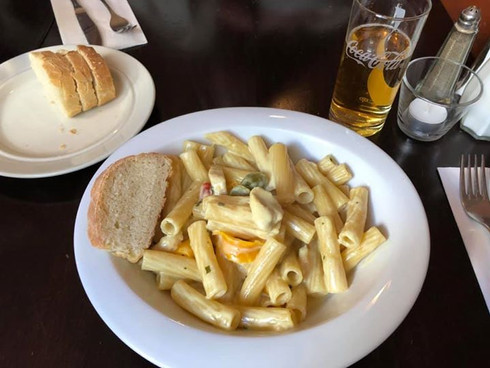- Sammy Kalski

- Feb 4, 2019
- 4 min read
Berlin, the capital city of the Federal Republic of Germany. Berlin, the city I have learned so much about. The Reichstag. The Berlin Wall. The Brandenburger Tor. I have dreamed of visiting this city; yet, I never thought I would that I would find myself there.
But I did find myself in Berlin last weekend on a trip organized by USAC. We left Friday afternoon and arrived around 6 pm. After checking into our hostel, we walked to Hackescher Markt for dinner. My friends and I ate at Restauration 1840 – great food, great atmosphere. I got my beloved Käse Spätzle, which is essentially the German version of mac and cheese.

Saturday was a walkathon but well worth every step. Snow-covered cobblestone streets and morning fog created a magical backdrop for the day’s events (until it started raining). The three-hour walking tour took us to the most well-known landmarks, starting with Museum Insel (Museum Island), which is self-explanatory. The pavilion along the river still has visible bullet holes – a common characteristic of Berlin architecture. As I mentioned in my Hamburg post, the rebuilding after WWII was intentional. Many buildings reused the old material; the new material is lighter in color, the old darker. Sometimes, the buildings will have a modern façade that doesn’t completely match.

From the Insel, we stopped at Humboldt University, where Einstein was a student. Across the street, in the Opernplatz (Opera Square) is the location of the Nazi book burnings. Over 20,000 books, written by Jews or contained material contrary to Nazi ideology, were burned. There is a memorial of empty shelves under a glass square. On the plaque reads this quote from German poet Christian Johann Heinrich Heine: „Dort, wo man Bücher verbrennt, verbrennt man am Ende auch Menschen (Where they burn books, they will, in the end, burn human beings too).” Heine’s statement is eerily accurate, but what makes it even eerier is that Heine wrote in his 1821 play Almansor, well over a hundred years before the Nazis. Heine’s books were among those burned.
Other memorable stops of our tour included Checkpoint Charlie, the Berlin Wall, the Memorial to the Murdered Jews of Europe, and the Brandenburger Tor. The Checkpoint Charlie standing today is only a replicable, and it’s mainly a tourist attraction now. Actors dressed as American military police guard the base, with whom you can take pictures for €3. I took a pass. Leading up to it is a wall covered with the history of East and West Berlin, the Wall, and Checkpoint Charlie. Next, we walked to a section of the Wall that’s still erect, which is across from a former Nazi government building turned into an administration building for East Berlin officials. The construction of the Wall happened overnight – no one saw it coming. The history of East Berlin feels entirely like a dystopian novel, but it was reality for over a million people. What I saw was history, not fiction. Our tour guide told us a story of a daring escape by the janitor of the building and his family. The guards thought that it was so well-executed that they assumed they were East Berlin spies.
The Memorial to the Murdered Jews of Europe (Denkmal für die ermordeten Juden Europas) was another powerful sight. Peter Eisenman designed the 200,000 sq. ft. memorial, on which 2,711 concrete slabs are organized in a grid pattern on sloping ground. They range from 8 inches to 15 feet tall, growing in height as you walk along the narrow alleys between them. Eisenman has given minimal reasoning behind his design, leaving it open for various interpretations. Personally, I felt more anxious the further I walked through the slabs. I felt alone, and I felt very small. To me, it echoes the despair of the victims and the orderly, bureaucratic nature of their murders. The memorial’s abstraction and vagueness are a point of controversy, but I disagree. A horror such as the Holocaust requires intentional contemplation to understand even a fraction of what occurred, and this memorial provides that prompt to do such.

The last stop on the tour was the Brandenburger Tor. It’s so cool in real life! The gate has been a symbol of peace and unity, but also separation, as it stood in a death zone between East and West Berlin. Here’s a tidbit of petty history (my favorite kind of history): France and Germany are rivals, so in 1806, Napoleon took the Quadriga (a chariot drawn by four horses) from the top of the gate as a spoil for defeating Prussia. In 1814, Prussia defeated Napoleon and they restored it to its rightful place, redesigned to clearly portray the goddess of victory. It faces east over the Pariser Platz, symbolizing victory over Paris (get it?? The Prussians were so clever.) On the West side of the gate, former President Ronald Reagan gave his famous “Mr. Gorbachev, tear down this wall!” speech.

A classical concert at the Berlin Konzerthaus was the last activity on Saturday. It was incredible! We listened to Franz Schubert’s Symphony No. 3 and Dmitri Schostakowitsch’s Symphony No. 13 in b-flat. Schostakowitsch’s piece included vocals, so we enjoyed an all-male choir from Finland, who sang in Russian in a German concert hall. I couldn’t stop smiling during the concert because I was in awe. Music is a universal language – it conveys emotions and stories as well as words do, sometime even better.

We toured Friedrich der Große’s (Frederick the Great) Charlottenburg Schloß (Charlottenburg Palace) on Sunday, our last day in Berlin. The elaborate décor is simply breathtaking. I loved imagining the rooms filled with guests and servants, bustling with activities of the royal inhabitants. In the afternoon, we had free time to check out the Berlin Flohmarkt (flea market). I bought a loose-fitting mustard blouse with a fun floral print, and I spent at least 20 minutes trying on vintage jean jackets – my weakness! Unfortunately (or fortunately for my wallet), my denim hunt was unsuccessful. The market vendors were a mix of a typical just-cleaned-out-my-grandparents-basement goods (re: old postcards, envelopes, cameras, Chinaware) to unique jewelry to art prints to vintage fatigues.
That was my Berlin trip in the briefest nutshell I could contain it. I loved every second of it! Berlin is also on my must return list, because even though we covered a bunch, there’s still more to explore.






















